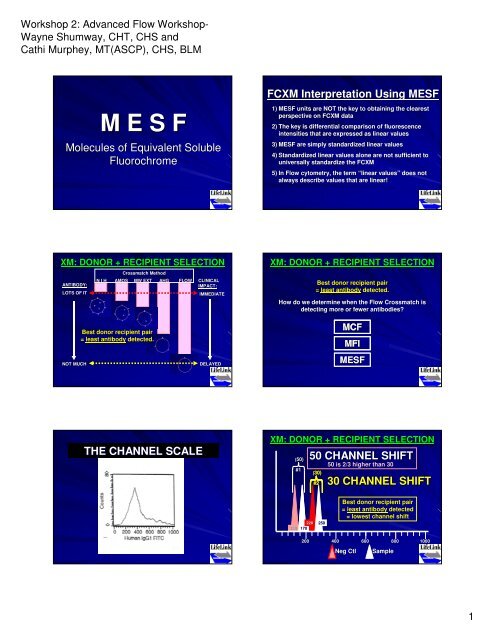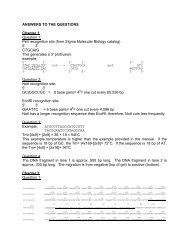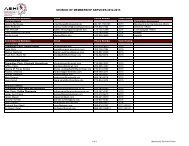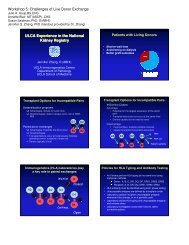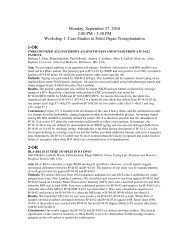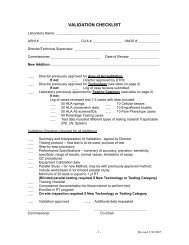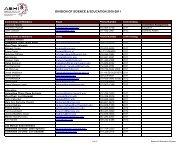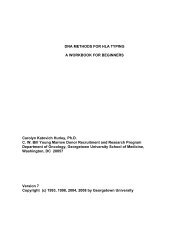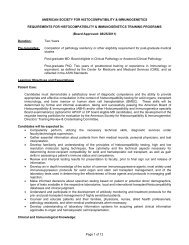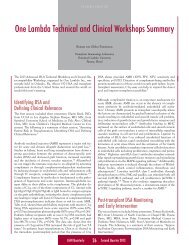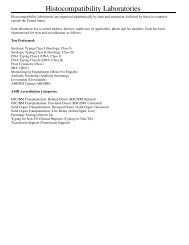Advanced Flow Workshop Shumway Murphey
Advanced Flow Workshop Shumway Murphey
Advanced Flow Workshop Shumway Murphey
You also want an ePaper? Increase the reach of your titles
YUMPU automatically turns print PDFs into web optimized ePapers that Google loves.
<strong>Workshop</strong> 2: <strong>Advanced</strong> <strong>Flow</strong> <strong>Workshop</strong>-<br />
Wayne <strong>Shumway</strong>, CHT, CHS and<br />
Cathi <strong>Murphey</strong>, MT(ASCP), CHS, BLM<br />
M E S F<br />
Molecules of Equivalent Soluble<br />
Fluorochrome<br />
FCXM Interpretation Using MESF<br />
1) MESF units are NOT the key to obtaining the clearest<br />
perspective on FCXM data<br />
2) The key is differential comparison of fluorescence<br />
intensities that are expressed as linear values<br />
3) MESF are simply standardized linear values<br />
4) Standardized linear values alone are not sufficient to<br />
universally standardize the FCXM<br />
5) In <strong>Flow</strong> cytometry, the term “linear values” does not<br />
always describe values that are linear!<br />
XM: DONOR + RECIPIENT SELECTION<br />
ANTIBODY:<br />
LOTS OF IT<br />
N I H<br />
Crossmatch Method<br />
AMOS<br />
MW EXT<br />
AHG<br />
FLOW<br />
CLINICAL<br />
IMPACT:<br />
IMMEDIATE<br />
XM: DONOR + RECIPIENT SELECTION<br />
Best donor recipient pair<br />
= least antibody detected.<br />
How do we determine when the <strong>Flow</strong> Crossmatch is<br />
detecting more or fewer antibodies?<br />
NOT MUCH<br />
Best donor recipient pair<br />
= least antibody detected.<br />
DELAYED<br />
MCF<br />
MFI<br />
MESF<br />
THE CHANNEL SCALE<br />
XM: DONOR + RECIPIENT SELECTION<br />
(50)<br />
#1<br />
50 CHANNEL SHIFT<br />
(30)<br />
#2<br />
50 is 2/3 higher than 30<br />
30 CHANNEL SHIFT<br />
220 250<br />
120 170<br />
Best donor recipient pair<br />
= least antibody detected<br />
= lowest channel shift<br />
200 400 600 800 1000<br />
Neg Ctl<br />
Sample<br />
1
<strong>Workshop</strong> 2: <strong>Advanced</strong> <strong>Flow</strong> <strong>Workshop</strong>-<br />
Wayne <strong>Shumway</strong>, CHT, CHS and<br />
Cathi <strong>Murphey</strong>, MT(ASCP), CHS, BLM<br />
Cutoff = 40 Channel Shift<br />
(50)<br />
#1<br />
(30)<br />
#2<br />
220 250<br />
120 170<br />
50 CHANNEL SHIFT<br />
30 CHANNEL SHIFT<br />
Best donor recipient pair<br />
= “no significant” antibody detected<br />
200 400 600 800 1000<br />
Neg Ctl<br />
= channel shift < Cutoff<br />
Sample<br />
Cutoff = 40 Channel Shift<br />
(50)<br />
#1<br />
(30)<br />
#2<br />
220 250<br />
120 170<br />
50 CHANNEL SHIFT<br />
30 CHANNEL SHIFT<br />
The “25% below cutoff” result<br />
identifies 1/3 more antibody than the<br />
channel shift that is not only 2/3<br />
higher – but also “25% above cutoff”<br />
200 400 600 800 1000<br />
Neg Ctl<br />
Sample<br />
Cutoff = 40 Channel Shift<br />
Monitoring Antibody Reduction<br />
(50)<br />
#1<br />
50 CHANNEL SHIFT<br />
(30)<br />
#2<br />
120 170 [50] 2.94 4.61 [1.67]<br />
30 CHANNEL SHIFT<br />
220 250 [30] 7.23 9.47 [2.24]<br />
Antibody Reduced by:<br />
Ch. Shift Reduced by:<br />
50%<br />
15%<br />
220 250<br />
120 170<br />
200 400 600 800 1000<br />
Neg Ctl<br />
Sample<br />
200 400 600 800 1000<br />
Neg Ctl<br />
Sample<br />
Reduced<br />
Fluidics & Optics<br />
Log “Mode”: 1024 data points in log relation (Log Amp)<br />
LASER<br />
FSC<br />
200 400 600 800<br />
1000<br />
SSC<br />
ADC<br />
FL-1<br />
FL-2<br />
FL-3<br />
Amplifier<br />
Log / Linear<br />
SHEATH<br />
SHEATH<br />
SAMPLE Injector<br />
Pulse<br />
Processor<br />
Pre-Amp<br />
200 400 600 800 1000<br />
Linear “Mode”: 1024 data points in linear relation<br />
2
<strong>Workshop</strong> 2: <strong>Advanced</strong> <strong>Flow</strong> <strong>Workshop</strong>-<br />
Wayne <strong>Shumway</strong>, CHT, CHS and<br />
Cathi <strong>Murphey</strong>, MT(ASCP), CHS, BLM<br />
W H E N I N L O G “M M O D E” E :<br />
Log “Mode”: 1024 data points in log relation (Log Amp)<br />
End of 1 st decade<br />
End of 2 nd decade<br />
End of 3 rd decade<br />
End of 4 th decade<br />
CHANNEL VALUES<br />
256 512 768 1024<br />
BD = “Log Data”<br />
Coulter = “Linear Data”<br />
1<br />
RLV<br />
200 400 600 800<br />
10 100 1000<br />
1000<br />
10,000<br />
10 0 10 1 10 2 10 3 10 4<br />
200 400<br />
600 800 1000<br />
200 400 600 800 1000<br />
Linear “Mode”: 1024 data points in linear relation<br />
Log “Mode”: 1024 data points in log relation (Log Amp)<br />
End of 1 st decade<br />
End of 2 nd decade<br />
End of 3 rd decade<br />
End of 4 th decade<br />
VALUES THAT WOULD HELP US BEST UNDERSTAND<br />
THE QUANTITATIVE RELATIONSHIP BETWEEN THESE<br />
TWO GROUPS OF PEOPLE?<br />
256 512 768 1024<br />
1<br />
RLV<br />
200 400 600 800<br />
10 100 1000<br />
1000<br />
10,000<br />
256 512<br />
1 2 3 4 5 6 7 8 910<br />
200 End of 1 st decade 400<br />
Fluorescence Intensity<br />
End of 2 nd decade<br />
20 30 40 50 60 70 100<br />
4<br />
96 additional units<br />
154 358 Channel Shift<br />
100<br />
512<br />
10 0<br />
RLV<br />
Log “Mode”: 1024 data points in log relation (Log Amp)<br />
End of 1 st decade<br />
End of 2 nd decade<br />
End of 3 rd decade<br />
256 512 768 1024<br />
200 400 600 800<br />
10 1 10 2 10 3<br />
Linear “Mode”: 1024 data points in linear relation<br />
End of 4 th decade<br />
1000<br />
10 4<br />
256 512 768 1024<br />
CHANNELS USED FOR<br />
“BINNING” DATA<br />
Variations in light intensity identifiable by PMT ~infinite<br />
Represented as a finite, linear range for practicality<br />
Entire range = 1024 increments (Channels)<br />
Linear Mode:<br />
0 – 1.0 1.1 – 2.0 3.1 – 4.0<br />
2.1 – 3.0<br />
200 400 600 800 1000<br />
Scales LOOK the same – BUT hidden log scale beneath in Log Mode!!<br />
In Linear Mode the channels ARE “numbers”!!<br />
Moving from the origin (0) to the end of the scale<br />
(1024), each subsequent channel serves as a “bin”<br />
for a higher range of values.<br />
3
<strong>Workshop</strong> 2: <strong>Advanced</strong> <strong>Flow</strong> <strong>Workshop</strong>-<br />
Wayne <strong>Shumway</strong>, CHT, CHS and<br />
Cathi <strong>Murphey</strong>, MT(ASCP), CHS, BLM<br />
Electronics<br />
Amplifier<br />
Log / Linear<br />
Linear Scaling<br />
(“normal numbers”: : movement<br />
along scale according to amount<br />
of increase)<br />
Log “Mode”: 1024 data points in log relation (Log Amp)<br />
Channels<br />
256 512<br />
Background<br />
2x<br />
4x<br />
200 End of 1 st decade 400<br />
End of 2 nd decade<br />
1 2 3 4 5 6 7 8 910<br />
Fluorescence Intensity<br />
20 30 40 50 60 70 100<br />
200 400 600 800 1000<br />
Fluorescence Intensity<br />
Integers that directly represent<br />
quantities of fluorescence<br />
CHANNELS USED FOR<br />
“BINNING” DATA<br />
Variations in light intensity identifiable by PMT ~infinite<br />
Represented as a finite, 4 log range for practicality<br />
Entire range = 1024 increments (Channels)<br />
Log Mode:<br />
1 X 1.009 X1.009 X1.009 X1.009<br />
Electronics<br />
Amplifier<br />
Log / Linear<br />
Background<br />
2x<br />
4x<br />
8x<br />
16x<br />
Log Scaling<br />
(movement along scale according<br />
to proportion of increase)<br />
32x<br />
128x<br />
64x 256x 512x 1024x 2048x<br />
Moving from the origin (10 0 ) to the end of the scale<br />
(10 4 ), each subsequent channel serves as a “bin”<br />
for a higher range of values.<br />
200 400 600 800 1000<br />
Fluorescence Intensity<br />
CHANNEL SHIFTS AND THE MULTIPLES OF<br />
THE “STARTING VALUE” (BACKGROUND<br />
FLUORESCENCE) THAT THEY REPRESENT<br />
MULTIPLE<br />
2<br />
3<br />
4<br />
5<br />
6<br />
7<br />
8<br />
9<br />
10<br />
1024<br />
SCALE<br />
77<br />
122<br />
154<br />
179<br />
199<br />
216<br />
231<br />
244<br />
256<br />
256<br />
SCALE<br />
19<br />
31<br />
39<br />
45<br />
50<br />
54<br />
58<br />
61<br />
64<br />
** Bottom Line – channel shifts represent a<br />
PROPORTIONAL relationship! **<br />
** Bottom Line – channel shifts represent a<br />
PROPORTIONAL relationship! **<br />
THEREFORE: “Channel Shift” and “MFI Ratio”<br />
are EXACTLY the SAME method of analysis!<br />
MFI<br />
Ratio<br />
2<br />
3<br />
4<br />
5<br />
6<br />
7<br />
8<br />
9<br />
10<br />
MCF<br />
Shift<br />
(1024)<br />
77<br />
122<br />
154<br />
179<br />
199<br />
216<br />
231<br />
244<br />
256<br />
(256)<br />
19<br />
31<br />
39<br />
45<br />
50<br />
54<br />
58<br />
61<br />
64<br />
4
<strong>Workshop</strong> 2: <strong>Advanced</strong> <strong>Flow</strong> <strong>Workshop</strong>-<br />
Wayne <strong>Shumway</strong>, CHT, CHS and<br />
Cathi <strong>Murphey</strong>, MT(ASCP), CHS, BLM<br />
XM: DONOR + RECIPIENT SELECTION<br />
Best donor choice = least<br />
fluorescence from<br />
secondary antibody<br />
3<br />
detected.<br />
FCXM #1<br />
3<br />
The quantity of signal<br />
XM:<br />
above background is of<br />
- Bkgnd:<br />
36<br />
200% of background<br />
significance (because it<br />
Aby:<br />
3<br />
(77 ch. . Shift)<br />
directly reflects the<br />
Y<br />
number of patient<br />
FCXM #2<br />
1<br />
antibodies bound), the<br />
XM:<br />
1<br />
proportion of background<br />
- Bkgnd:<br />
12<br />
200% of background<br />
is IRRELEVANT*!<br />
Aby:<br />
1 (77 ch. . Shift)<br />
*with regard to the number of antibodies present<br />
Y<br />
Y<br />
Y<br />
Y<br />
Y<br />
Y<br />
Y<br />
Channel Shifts and the Illusion of Increased<br />
Sensitivity When Using Pronase<br />
Y Y<br />
The same number of<br />
Untreated B Cells<br />
antibody molecules<br />
XM:<br />
binding against a lower<br />
- Bkgnd:<br />
background produce a<br />
36<br />
greater channel shift – Aby:<br />
3<br />
but remain the same<br />
77 ch. . Shift<br />
number of antibody<br />
molecules!<br />
Pronase Treated B Cells<br />
Linear data reflects the<br />
XM:<br />
true quantity above<br />
- Bkgnd:<br />
14<br />
background – a value<br />
Aby:<br />
3<br />
that is independent of<br />
154 ch. . Shift<br />
the background.<br />
Y Y<br />
Y<br />
Y<br />
Y<br />
3<br />
Y<br />
Y<br />
1<br />
Y<br />
Y<br />
Y<br />
3<br />
background<br />
1<br />
background<br />
Relative Linear Values (RLV) are frequently referred to as MFI (Median<br />
or Mean Fluorescence Intensity) values. It is these RLV / MFI values<br />
that are “numbers” in the conventional sense (NOT the channel<br />
values!), they have simply been plotted on a log scale. Events with an<br />
MFI value of 600 are twice as bright as those with an MFI of 300 (the<br />
expected, conventional, “linear” relationship). HOWEVER, if an event<br />
reads at channel 600, an event half as bright will read at channel 523.<br />
So how do we convert the channels to<br />
the “numbers”?<br />
CHANNEL VALUE<br />
Calculate “R” = the<br />
channel value divided<br />
by channels per decade<br />
512<br />
512/256 = 2<br />
End of 1 st decade<br />
End of 2 nd decade<br />
End of 3 rd decade<br />
256 512 300 768 1024<br />
200 400 600 600 800<br />
End of 4 th decade<br />
1000<br />
10 R = RELATIVE<br />
LINEAR VALUE<br />
(RLV – aka MFI)<br />
10 2 = 100<br />
1<br />
RLV<br />
10 100 1000<br />
Fluorescence Intensity<br />
10,000<br />
W H E N I N L O G “M M O D E” E :<br />
CHANNEL VALUES<br />
BD = “Log Data”<br />
Coulter = “Linear Data”<br />
RELATIVE LINEAR VALUES<br />
BD = “Linear Data”<br />
Coulter = “Log Data”<br />
End of 1 st decade End of 2 nd decade End of 3 rd decade<br />
End of 4 th decade<br />
256 512 768 1024<br />
RELATIVE LINEAR VALUE<br />
is a much better term than<br />
Median Fluorescence Intensity<br />
1<br />
RLV<br />
200 400<br />
600 800 1000<br />
10 100 1000 10,000<br />
5
<strong>Workshop</strong> 2: <strong>Advanced</strong> <strong>Flow</strong> <strong>Workshop</strong>-<br />
Wayne <strong>Shumway</strong>, CHT, CHS and<br />
Cathi <strong>Murphey</strong>, MT(ASCP), CHS, BLM<br />
1<br />
“RELATIVE” LINEAR VALUES<br />
RLV-BD<br />
0.1 RLV-BC<br />
10 100 1000 10,000<br />
1 10 100 1,000<br />
64<br />
128 192<br />
50 100 150 200 250<br />
End of 1 st decade<br />
End of 2 nd decade<br />
End of 3 rd decade<br />
256 512 768<br />
256<br />
End of 4 th decade<br />
1024<br />
“RELATIVE” LINEAR VALUES<br />
Current XM:<br />
Last XM PMT settings<br />
X 4 =<br />
Last XM:<br />
Last XM PMT settings<br />
MCF = 256 MCF = 410<br />
MFI Ratio = 4<br />
MCF = 77 MCF = 231<br />
MFI Ratio = 4<br />
154 MCF shift 154 MCF shift<br />
8 – 2 = 6 MFI Shift 40 – 10 = 30 MFI Shift<br />
400%<br />
OF BACKGROUND<br />
400%<br />
OF BACKGROUND<br />
200 400 600 800 1000<br />
1<br />
2 3 4 5 6 7 8910<br />
200 400<br />
20 30 40 50 60 70 100<br />
“RELATIVE” LINEAR VALUES<br />
X 4 =<br />
Current XM:<br />
NEW XM PMT settings<br />
MCF = 256 MCF = 410<br />
MFI Ratio = 4<br />
154 MCF shift<br />
40 – 10 = 30 MFI Shift<br />
400%<br />
OF BACKGROUND<br />
“RELATIVE” LINEAR VALUES<br />
X 4 =<br />
Current XM:<br />
CONSTANT PMT settings<br />
Last XM:<br />
CONSTANT PMT settings<br />
MCF = 256 MCF = 410<br />
MFI Ratio = 4<br />
MCF = 77 MCF = 231<br />
MFI Ratio = 4<br />
154 MCF shift 154 MCF shift<br />
8 – 2 = 6 MFI Shift 40 – 10 = 30 MFI Shift<br />
400%<br />
OF BACKGROUND<br />
400%<br />
OF BACKGROUND<br />
1<br />
2 3 4 5 6 7 8910<br />
200 400<br />
20 30 40 50 60 70 100<br />
1<br />
2 3 4 5 6 7 8910<br />
200 400<br />
20 30 40 50 60 70 100<br />
MESF Values **<br />
**** MESF Values are Independent of Instrument and Settings ****<br />
200,000<br />
50,000<br />
12,500<br />
MESF line at initial PMT settings<br />
MESF line at increased PMT settings<br />
** Relative<br />
positions are not<br />
to scale. For<br />
illustration only.<br />
MESF Acquisition<br />
2 8 10 40<br />
Cytometer Scale (RLV) **<br />
Reference<br />
Bead MESF<br />
2546<br />
6393<br />
19019<br />
47474<br />
6
<strong>Workshop</strong> 2: <strong>Advanced</strong> <strong>Flow</strong> <strong>Workshop</strong>-<br />
Wayne <strong>Shumway</strong>, CHT, CHS and<br />
Cathi <strong>Murphey</strong>, MT(ASCP), CHS, BLM<br />
Universal Standardization of the FCXM<br />
Will Require More Than MESF<br />
Conversion due to the Variability of:<br />
1) FCXM protocols<br />
2) Secondary Ab characteristics<br />
3) Negative control sera reactivity<br />
4) HLA expression<br />
FCXM Interpretation Using MESF<br />
1) The key to obtaining the clearest perspective on FCXM<br />
data is the differential comparison of fluorescence<br />
intensities that are expressed as linear values<br />
2) MESF are simply standardized linear values<br />
3) If a lab FCXMs on multiple instruments, MESF<br />
conversion provides a convenient way to standardize<br />
data between machines - BUT<br />
4) MESF conversion alone is not sufficient to universally<br />
standardize the FCXM between laboratories<br />
5) MESF reference lines can be used to verify the proper<br />
functioning of fluorescence detection systems<br />
Auto XM<br />
Negative<br />
Positive Donor XM<br />
IS NOT<br />
Due to auto-ab<br />
ab<br />
Patient Cells +<br />
Patient Serum<br />
Positive<br />
Positive Donor XM<br />
MAY BE<br />
Due to auto-ab<br />
ab<br />
Negative<br />
Positive Donor XM<br />
IS NOT<br />
Due to auto-ab<br />
ab<br />
Patient Cells +<br />
Patient Serum<br />
Positive<br />
Positive Donor XM<br />
MAY BE<br />
Due to auto-ab<br />
ab<br />
Cell Washer<br />
IF Positive Donor XM<br />
Donor Cells + Donor Adsorbed patient serum<br />
Negative<br />
HLA-ab<br />
likely<br />
Positive<br />
HLA-ab<br />
NOT likely<br />
7
<strong>Workshop</strong> 2: <strong>Advanced</strong> <strong>Flow</strong> <strong>Workshop</strong>-<br />
Wayne <strong>Shumway</strong>, CHT, CHS and<br />
Cathi <strong>Murphey</strong>, MT(ASCP), CHS, BLM<br />
Advantages of an Automated Cell Washer:<br />
1) Uniform and consistent washes – therefore<br />
2) No wash technique effects on results<br />
3) Wash processing time reduced 85-95%<br />
Advantages of an Automated Cell Washer:<br />
1) Uniform and consistent washes – therefore<br />
2) No wash technique effects on results<br />
3) Wash processing time reduced 85-95%<br />
Disadvantages of an Automated Cell Washer:<br />
1) .<br />
2) .<br />
3) .<br />
Highly Recommended:<br />
Helmer Ultra CW<br />
www.helmerinc.com<br />
1.800.743.5637<br />
8


